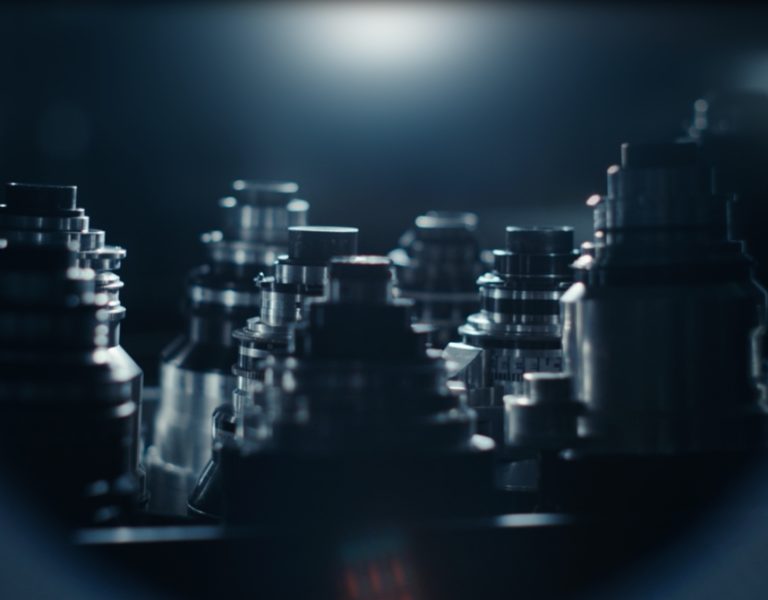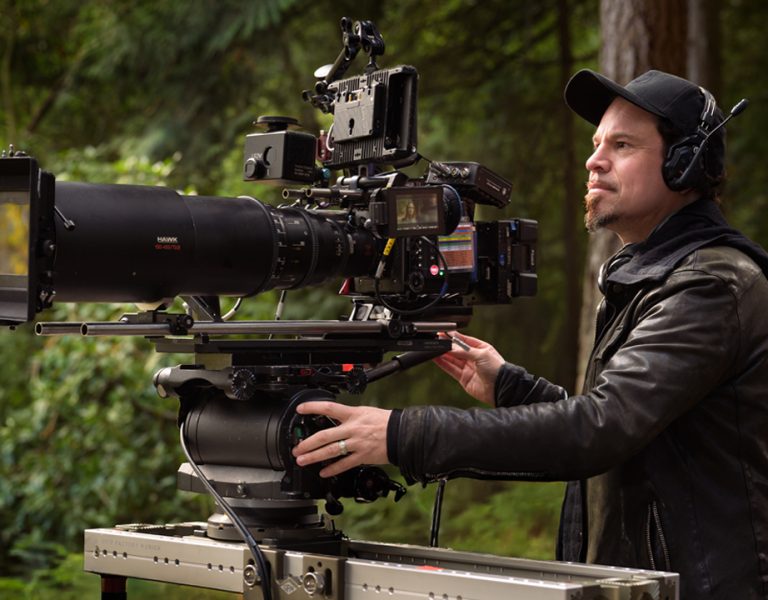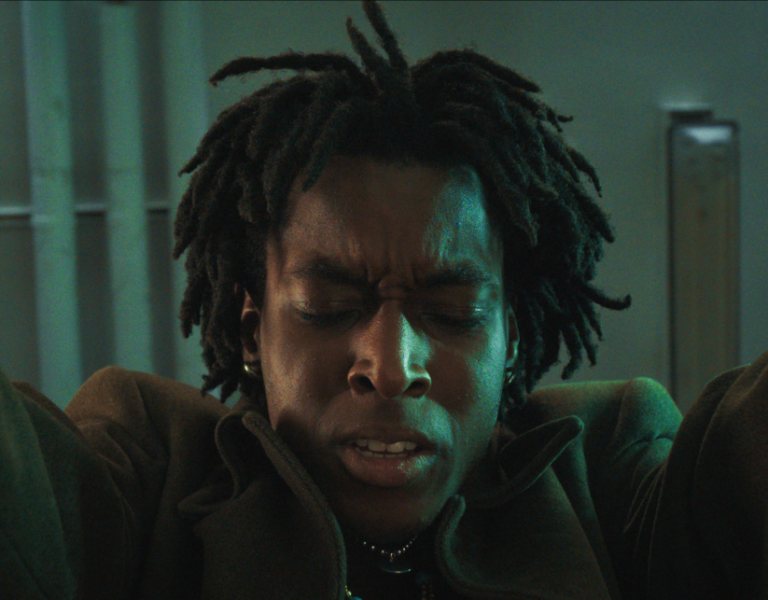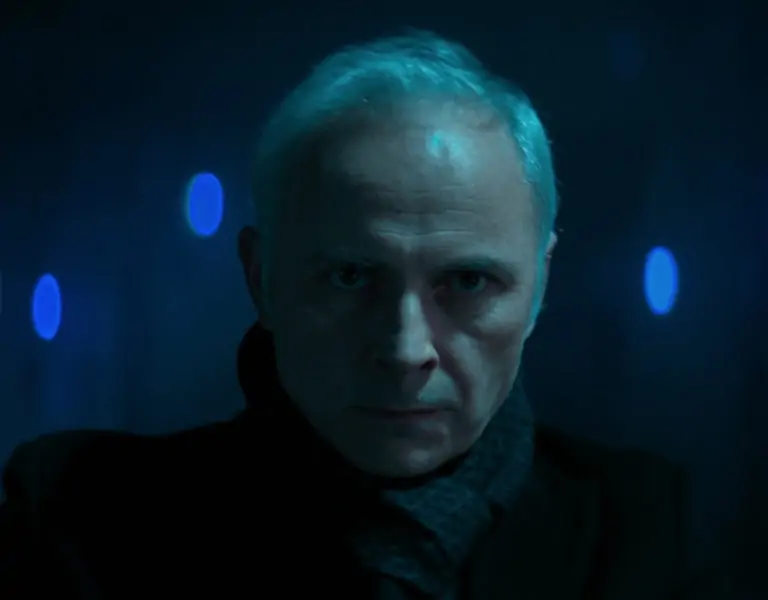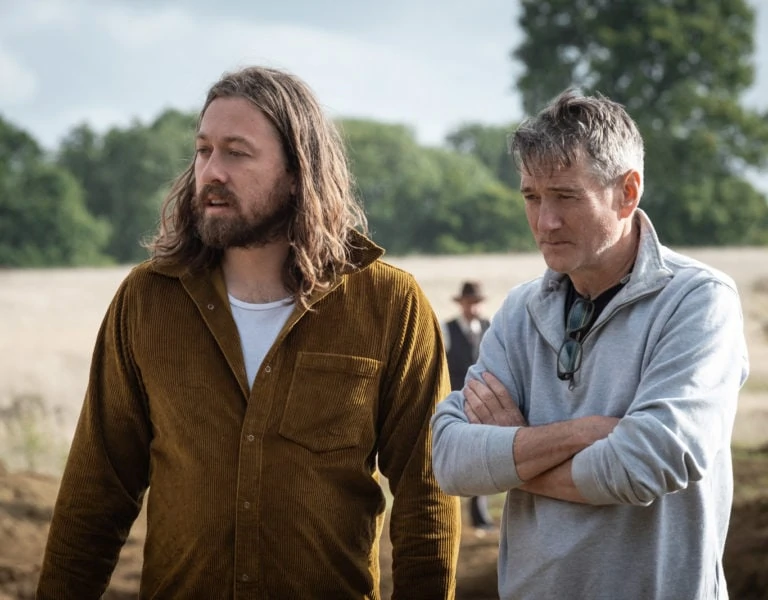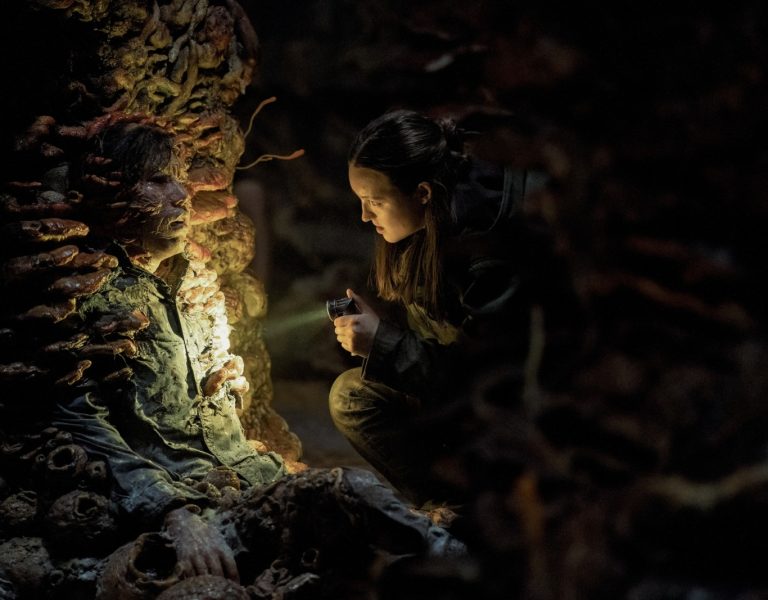DYNAMIC CAMERA AND LIGHTING
DP Ray Wongchida on shooting a comedy-drama film, revolving around a woman who has faced a series of challenges, including pandemic isolation and ramen shortages
What specific camera angles and techniques did you employ to capture the contrast between the humorous and emotional moments? How did these choices enhance the storytelling?
We came up with some rules of cinematography early in pre-production. Every character should be introduced with their footwear, giving insight into their personality. Since the story setting was Los Angeles in the middle of the Covid-19 pandemic, any exterior shots would be handheld, evoking the uncertainty and instability people felt when leaving their homes. Also, because a lot of dramedies live in a more compressed space in the middle of the spectrum, where the comedy is more subtle and dry, and the drama doesn’t push too dark. The directors, David Lassiter and Sharaé Nikai wanted The Other, Gold, to push closer to the extremes. The comedy writing on the page was incredible, but was greatly enhanced by the improvisation the directors asked of the actors. To fully cover and kick up the whimsical nature of the improvisational comedy, we decided to cross-shoot handheld for most of the improv work. We made an exception for the Barber Shop scene. It takes place in Atlanta, and the sentiment about sheltering was different there. Also, because there were so many characters in each shot at the barber shop, a stabilised look helps the audience track the actors’ brilliant performances.
Can you elaborate on the specific lighting techniques you used to differentiate between the lighthearted and intense scenes – and how did you ensure consistency in the film’s visual tone?
The setting of the Covid-19 pandemic greatly influenced the look of the film. I think a polished lighting look would be wrong for this movie and setting. We felt we wanted to represent the uncertainty, scarcity, and essentials-only mentality of the pandemic by using natural daylight when possible. In the exterior daytime scenes, we also knew we wanted an overcast look. There’s something about an overcast day that evokes an LA winter stay-at-home-cause-you’re-sick mood. Since we were cross-shooting for the improv scenes, we knew we couldn’t control the light with large overhead frames in a way that would allow for proper freedom for the actors and cameras. So, we waited for the real thing and scheduled our shoot days when the weather forecast was promising. We also found locations where the surrounding buildings worked as negative fill to build some contrast. With the more dramatic nighttime scenes, we wanted a low-key higher contrast look. It was very important to Sharaé that Farrah’s apartment decor fit Farrah’s character, so our gaffer, Chad Harrell, and I worked with Sharaé and David for practical light placement. Chad is a magician with practical lighting. He found ways to add small, practical lights that bounced to create wonderful, unexpected sources. Fortunately, the blocking in our nighttime scenes was pretty simple. This allowed us to shape light more easily for the characters by varying the brightness levels of our practical lamps and augmenting them with suspended lanterns.
The Other, Gold draws inspiration from My Dinner with Andre. How did this influence your approach to cinematography, particularly in scenes that unfold primarily in one room?
My Dinner with Andre was a reference for the concept of the film, and the Directors were clear that it was not a visual reference. When Sharaé Nikai wrote the film, she wanted the movie to center around candid discussions of friendship and society. With that said, when all you have are people sitting and discussing things, it will always be important to show actors’ faces and body language, but there’s always a challenge to keep it visually interesting. In the scene where Dionne comes to meet Farrah at Farrah’s apartment for the first time in 5 years, Sharaé and David wanted to make sure that there was a progression in how close they physically were to each other and how close they felt visually. What’s more, they wanted Farrah and Dionne to converse in different areas of the apartment to keep it visually interesting. As their meeting progresses from day into night, we set up shots that increasingly feel more intimate. They start off in the daytime, standing with a kitchen island separating them, and we use handheld coverage to feel the tension. After they have had time to get comfortable with each other, they eventually move to a couch but still sit across from each other. At this moment, we are on a geared head because there’s peace between them now. Also, it’s night, and the tungsten-colored practical lighting feels intimate. Eventually, they move to the same side of the couch. We frame a romantic two-shot with twinkling city lights beyond them, and, for the first time, we use a panning shot to feel their faces together in a close-up. Finally, when Farrah reveals the racist incident, it’s late in the night and the two characters are standing with quite a bit of distance between them. We wanted a depleted and exhausted look for this scene. So, we shot wider frames to minimize and isolate Farrah. We also turned off some of the lamps, and the lamps that were on, we pushed slightly cooler. We still had all these twinkling city lights in the background, and they added too much life to the frame. So, we flagged off city lights outside the windows to reduce the life in her environment.

What were the advantages and challenges of relying on natural light, and how did you ensure that it met the emotional and narrative needs of each scene?
The directors and I love natural daylight. There’s a quality to it that’s essentially impossible to replicate through lighting fixtures and modifiers alone. You’re never going to get the same depth of light and as large a source as the sky. The reason I think natural light resonates with everyone visually is similar to the reason I think we can all appreciate good acting. Most people, since birth, have dealt with seeing and reading human faces and emotions. Because of that, a vast majority of people are somewhat experts at feeling human emotion through facial expressions. Similarly, I think most see and feel the quality of natural light every day, and because of that, we can all feel to some degree if something is lit with artificial light sources. However, using natural light can force you to flip the standard approach used when working with lighting fixtures. Instead of moving lighting fixtures to light your subjects and environment, you must move your subjects and environment for the natural light. Because of this, blocking the direction of the natural light was critical. I worked with the Directors to find blocking that worked for the actors, the story, and the light. We went as far as rearranging the set furniture and decorations to accommodate natural light through windows. It was quite challenging at times, but I was lucky that the Directors actually enjoyed the process. I think we found solutions that worked well for the film overall.
Given that multiple cameras were used to capture performances, how did you coordinate between different camera angles and shots to maintain fluidity and coherence in the film?
All of our improv scenes were grouped into two days of shooting, the rest of the movie was shot single camera. For the two days of improv, we ran two ARRI Alexa XT Plus cameras. I’m a huge fan of the XT Plus, as it’s currently the most inexpensive way to internal Open Gate ARRIRAW recording. Since a lot of our improv was going to be shot handheld, I prefer full-size Alexas for better balance and inertia for stability. I always operate when I’m shooting a single camera. But, for this particular movie, it made more sense for us to use two camera operators so that I could be by the monitors with the directors. We had a secret weapon when cross-shooting the improv. Our wonderful editor, Greg Karpinski, is also a talented camera operator. So, we hired Greg to operate B cam while our 2nd unit director of photography, Dan Jamal Weekes, operated A cam. As a result, we had our editor on set to consult as well. With me free to watch the monitors with the directors and our editor on set to discuss the shots, we had no problem deciding on the coverage and angles we wanted. I think the traditional cross-shooting strategy is to use a longer lens to sniper in, making it easier to keep cameras and lighting out of each other’s shot. Our cross-shooting situation was unusual in that most of our shots were wider than traditional coverage. This meant we had to light spaces, not faces. But, once the lighting was done, it gave us quite a bit of compositional freedom, given the situation. In addition to the cross coverage we needed, we always made sure to have some takes that prioritised a creative A cam two shot over the B cam angle.

The Other, Gold, directed by Sharaé Nikai/David Lassiter
The scene where Farrah explains a racist incident in an elevator was crucial to the film’s tone. How did you use lighting to convey Farrah’s feelings in this scene?
This was one of the most important scenes in the movie. Farrah and Dionne had been talking all night, and it was late. They had long since moved past catching up and were now in a very raw, vulnerable place.. To reflect this, we wanted the lighting at this moment to feel simplified and distilled, motivated primarily by practical lights placed around the room. Our gaffer, Chad Harrell, had replaced every bulb with Astera NYX bulbs so we could match a specific tungsten colour across the room and have greater brightness control. We wanted to isolate Farrah even more from her lifeless world, so we needed a key light source that could be soft enough to feel environmental but fall off quick enough to aid Farrah’s environmental separation. We chose a pancake lantern mounted above and near Farrah, skirted off the walls for greater subject separation. To help the surrounding frame feel even more lifeless, we placed some flags outside to minimize the twinkling city lights beyond the windows.
How did you integrate practical lighting into the set design, and what were some of the most effective practical lighting techniques you used?
Most of the movie was about daytime interiors and exteriors. But one of the most important parts of the movie is when Dionne visits Farrah for the first time in five years. Dionne’s visit starts in the daytime and moves into the night, and it all takes place in Farrah’s apartment. Because of our wider shot philosophy, we knew we would be seeing a lot of Farrah’s apartment in the frame. Our Gaffer, Chad Harrell, and I worked closely with the Directors to have floor and table lamps of the right height and appropriate diffusion in the shades. We also had mock wall sconces put up, and Chad placed Aputure MC lights in some brilliant places to produce decorative bounce lights. Later, the Delivery Guy, played by one of our Directors, David Lassiter, shows up, and Farrah and him eat outside on the patio. For that scene, we placed a fire element in the background behind Farrah. Chad also placed quite a few MC lights to uplight the surrounding vegetation. He also placed Astera Titan Tubes on the ground along some walls and fencing to produce some splashes of teal to contrast the surrounding tungsten and fire lighting.
When enhancing Farrah’s feeling of isolation, how did you balance these wider shots with more intimate close-ups, and what was your strategy for using spatial composition to reflect Farrah’s emotional journey?
Isolation was a major theme in this movie and was treated like a character. It is prevalent in this film for so many reasons: isolation because of the pandemic, isolation because of the death of loved ones, and isolation because of the loss of friendship. Of course, with the nature of composing for 2.39:1, there is an inherent wideness to the frame. Even in close-ups, you will have some environment in there. We chose scope for that very reason. For a Covid-19 pandemic movie, we wanted to feel the emptiness of the environment around our characters and the isolation that goes with that. This Isolation character was represented by a mostly people-less environment in almost every frame, ubiquitous and inescapable. So, in a way, we thought of a single shot like a two shot of the primary character and Isolation as the second character. For the most part, because close-ups minimize the character of Isolation, they were our new single shot and were used when we wanted the audience to truly only focus on a character. Even in the scene where Farrah describes a racist event, we stay in a medium shot. I think a more classic approach to Farrah’s coverage there, would have the camera placed between Farrah and Dionne, a tight eye line, with a medium close-up to close-up dolly in. But that moment is so painful, so raw, that it would feel too confrontational and uncomfortable to the audience to be right there in front of her. When you feel that uncomfortable, sometimes it’s hard to truly listen. There’s something about witnessing something that painful from an observational perspective that allows the audience to feel removed and just safe enough to truly take in everything Farrah is feeling. It’s one of the few times I felt like I wanted to forgo a movie’s ability to put the audience right in there and take a live theatre perspective.
What were some of the key technical preparations and research steps you took before shooting began?
When the writer / director, Sharaé, first approached me with the finished script, she told me that there would be key scenes with extensive improv, and it was very important to her to capture everyone’s performance when shooting the improv scenes. I think most DoPs have concerns with cross-shooting and how it might limit options with camera placement and lighting. But, the comedic improv in this movie is exceptional, and prioritizing cross-shooting during improv was absolutely the right choice. Because of this, I sought out info regarding shows I admire that had to cover improvisation from their actors. One show I particularly admire visually, as well as from a writing perspective, is Hacks. I found some inspiration and insight from an interview with the Hacks DoP, Adam Bricker and it motivated me to light with practical lighting as much as possible. I worked closely with the Gaffer, Chad Harrell, to make sure that we were lighting whole spaces for the improv scenes. This gave us greater freedom for better compositions in a multicam situation. Another situation I had to address was the shaping of light during our cross-shooting for daytime exteriors. We had decided to wait for overcast days to shoot those scenes, but it was important to me to build some lighting contrast without impeding on the actors’ freedom. We spent quite a bit of time scouting for locations that had large dark buildings we could use as practical negative fill. Our locations worked quite well in shaping the natural overcast light while providing freedom for the actors and cameras to move where they wanted to.

What were the biggest challenges you faced in terms of cinematography and how did you and your team address these challenges to achieve the desired cinematic effect?
The biggest challenges were the ones inherent to shooting during the Covid-19 pandemic. There were a lot of people that weren’t ready to go out and shoot. Also, people were sick at different times, so this greatly limited our pool of willing crew, and the day’s crew members were actually available. We ended up shooting the movie in fifteen days over roughly three months. We needed to be flexible with shoot dates to accommodate when crew and actors could come together in a safe manner. With little sporadic time and few people, we really leaned into the saying that ‘Filmmaking is Jazz, not Math.” We relied on all our previous knowledge and experience, planned as much as we could in pre-production, and then got ready to let go of everything and just play the moment. Luckily, our planning was mostly relevant, and we made all of our days. The small crew that we brought on was carefully chosen, and I knew they all were ready to wear multiple hats when needed. I attribute our success to Production’s patience and flexibility. When you need the right people for the job, it’s worth the wait.

